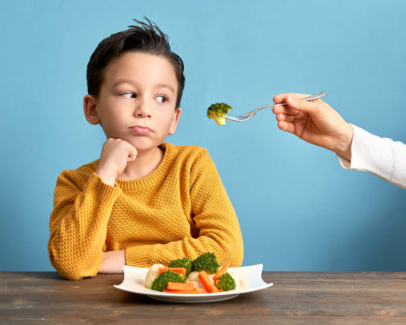Many toddlers and preschoolers are actually good buddies at mealtimes. They often see eating as a natural response to hunger and eating as a pleasant social experience.
On the other hand, it is also common for children between the ages of 3 and 5 to develop specific food preferences (seemingly overnight). In some cases, they will only eat yellow foods or foods that are completely covered in applesauce. In other cases, the total number of foods chosen is reduced to five, one of which is potato chips. This can be frustrating, to say the least.
Stay Calm and Proceed
One thing parents need to come to terms with: the day is full of inconsistencies, so don’t panic. Your child may not be as hungry at times because she was less active the day before. She may see another child eating something you would never think of for dinner, such as a frozen doughnut. Cheer up: When a child stubbornly eats at this age, it’s part of learning Xi independence and control.

Control and more control
Children often use food to show control, which is natural for preschoolers. Even in the most difficult times, children do not go hungry and rarely lose weight. However, if you do suspect weight loss, or if you notice other symptoms of illness, such as fever, nausea or diarrhea, and sudden changes in appetite, talk to your child’s healthcare provider.
How to Get Picky Eaters to Eat Toddlers: Eating Strategies?
Here are some strategies to help you and your child enjoy a more enjoyable mealtime:
- Provide nutritious food for your child and let her decide what to eat and how much. You are the provider, she is the eater. Everything at home and at the table is in your hands; She can control what is in her mouth.
- She is expected to mimic her peers in terms of likes and dislikes, and these preferences are constantly changing.
- Fights over food are common, and food gets lost in the fight. These do have to do with control. Know what you can control and what you can’t.
- The best advice is for parents and other people who are often cared for to be good role models. Eventually, the children will eat the way their families do.
- Practice healthy eating behaviors, including offering/choosing a variety of foods, trying new foods, and not overeating.
- Whenever possible, eat together as a family.
- Create a relaxed atmosphere during meals and try not to rush your child. On the other hand, if it took her more than 30 minutes to finish, then she wasn’t really hungry, so give it up.
Food Ideas for Picky Eaters
Your child’s basic eating Xi today may stay with him for the rest of his life. Here are general guidelines to help your child get enough (but not too much) food. Keep in mind that the quantity and selection may vary from day to day.
1. Provide small portions, only offer a second if your child asks for it.
Some acceptable children’s servings include:
- 4-6 ounces of milk or juice
- 1 slice of toast
- 1/2 cup yogurt or cottage cheese
- 4 tablespoons vegetables
- 2 ounces hamburger
- 1/2 cup cereal

2. Limit snacks to three servings per day, focusing on low-fat foods, fruits, and fresh vegetables rather than soft drinks, sweets, pastries, and salty or greasy foods. Extra snacks may reduce your child’s appetite. Plan the time to snack and avoid grazing.
Nutritious snacks for preschoolers include:
- fruit
- Fruit juice (limit juice to 4 to 6 ounces per day)
- Carrots, celery or cucumber strips
- Cheese sticks
- yoghurt
- Toast or crackers with cheese
- Oatmeal crackers
- Finger sandwich (i.e. 1/8 of the sandwich) or bran muffin
3. Make sure your child is indeed hungry or thirsty when they ask for food or drink. He may just want some attention, so try talking or playing first. Try not to use food as a pacifier.
4. Milk intake is limited to 16 ounces per day for this age group. Milk is a very important food, but too much of it may reduce your child’s appetite for other important foods.
5. Encourage your child to try new foods by offering small portions of food to taste rather than insisting that he eat whole unfamiliar foods. On average, children need to taste seven times before they accept a new food.
6. Avoid eating when distracted by TV or other screen devices, games, or stories. These other activities can be distracting. In addition, advertising can also influence your child’s food choices. Children at this age are receptive to stoppers of sugary cereals and sweets, especially after they have been to other homes that offer these foods. During the day, less than 5% of food ads are for “good” foods like fruits and vegetables. The more commercial TV kids watch, the more likely they are to need less nutritious snacks and the less interested they are in healthier alternatives.
7. Ask your child to help choose and prepare food. Children love to help out and will be proud of their contributions.
8. Encourage conversation when everyone is at the dinner table. Nothing helps digestion better than a pleasant atmosphere!
Sustained weight gain and a ratio of height to body weight are the best signs of good nutrition. Get regular health check-ups and review the growth chart at your healthcare provider’s office to stay safe.

